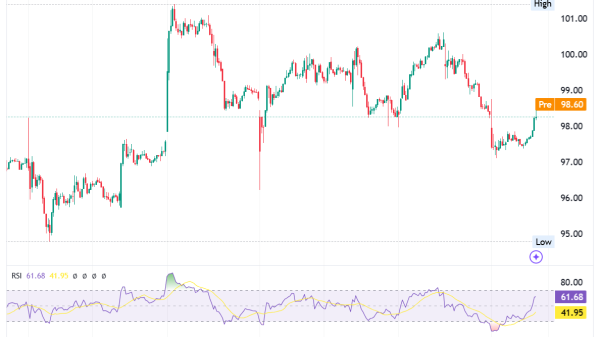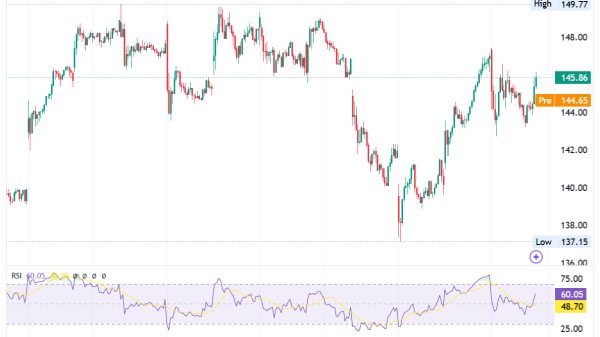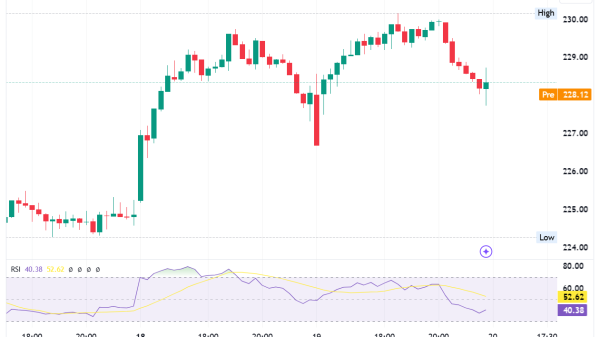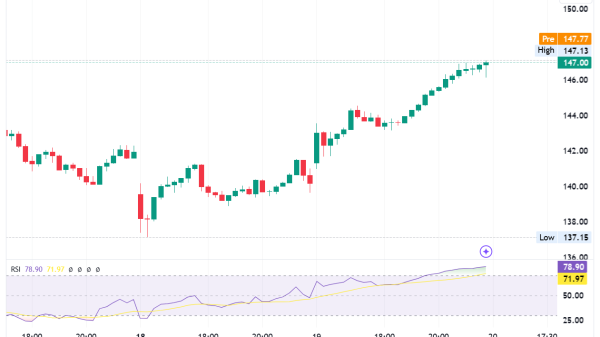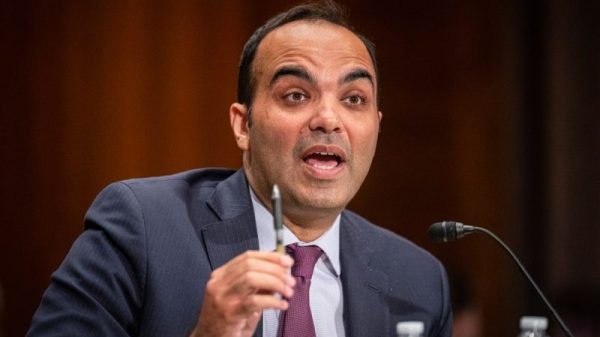
Twenty-year-old Sam Srisatta is giving a month of his life to science — research that could help shape the future of US nutritional and regulatory guidance about the ultraprocessed foods that make up nearly 70% of the nation’s food supply.
By 7 a.m. each day in his hospital room, nurses record Srisatta’s weight and vitals. Bowel movement samples are captured for analysis. Some mornings, blood is drawn to test how his body reacts to the different types of foods he consumes. Other days, he lies in a bubble that measures his oxygen and carbon dioxide output to determine how many calories he burns while at rest.
After each morning’s battery of tests is complete, Srisatta has 15 minutes to eat his breakfast before the food is removed, weighed and recorded. At lunch and dinner, he has a full hour to eat as much or little as he likes before the leftovers are whisked away to be measured, and additional vitals are captured. Then he is free to read, play video games, exercise with supervision or fall asleep.
It’s a routine he and 35 other volunteers repeat for four weeks as they live inside the Metabolic Clinical Research Unit of the National Institutes of Health Clinical Center in Bethesda, Maryland — part of a unique randomized clinical trial designed to tease out the health impact of different types of ultraprocessed foods.
“These are industrially manufactured formulations from refined ingredients and additives that you typically don’t find in your home kitchen or restaurant,” said Kevin Hall, a senior investigator with the National Institute of Diabetes and Digestive and Kidney Diseases in Bethesda, who is leading the study.
Ultraprocessed foods typically contain combinations of sugar, salt and fats designed to maximize the “bliss point” of a food, making it potentially irresistible — much like the 1960s Lay’s potato chip ads starring actor Bert Lahr, famed for playing the Cowardly Lion in “The Wizard of Oz,” who said, “Betcha can’t eat just one.”
Potential pitfalls of ultraprocessed foods
Advances in food science over the decades since have created even more artificial flavors, smells and textures that experts say home-cooked meals can no longer replicate. These additives, along with high levels of sugar, salt and fat, help create the overwhelming lure of ultraprocessed foods.
Numerous studies find higher amounts of ultraprocessed food raise the risk of obesity and the development of chronic conditions including cancer, cardiovascular disease, obesity, type 2 diabetes and depression. Such foods may even shorten life.
“These and other diet-related conditions account for at least half of all US deaths, disproportionately impacting Black, indigenous, low income and rural Americans, and contribute to $4.5 trillion in annual health care costs,” top officials for the US Food and Drug Administration wrote in a mid-November editorial on the dangers of ultraprocessed foods.
But do all overly processed foods cause the same harm? The question is puzzling scientists and slowing down regulatory action, critics say.
“There’s a lot of debate about whether or not all ultraprocessed foods are bad for you,” Hall said. “Probably not, so what are the mechanisms in this big, broad category of ultraprocessed foods — which make up somewhere between 50% and 70% of the calories available in our food supply — what are the mechanisms that drive poor health?
“If we can figure that out, then we can provide our colleagues at the FDA and regulators with information about how they might want to label foods, for example, or policymakers on how they may want to change policies,” Hall said.
An extra 500 calories per day
Hall and his team have previously researched the appeal of ultraprocessed foods. A prior study, published in July 2019, sequestered healthy volunteers from the outside world for a month, feeding them ultraprocessed food, including sugary cereals and blueberry muffins, for two weeks and minimally processed foods, such as Greek yogurt with fresh fruit and nuts, for another two weeks. Participants were able to eat as much or little of each diet as they liked.
Both diets contained the same number of total calories, sugars, fiber, fat, salt and carbohydrates, so Hall expected the food and drink to have a similar impact on the bodies of the 20 volunteers — but that’s not what happened.
“What we saw in that previous study was that people tended to overeat the ultraprocessed foods diet by about 500 calories per day more than when the same people were exposed to the environment with zero ultraprocessed foods,” Hall said.
A recent, much smaller randomized clinical trial in Japan, which fed nine sequestered volunteers a week of ultraprocessed and a week of minimally processed food, found a much larger result — people on the ultraprocessed diet ate an additional 813 calories per day.
“In Hall’s study, these people were in a locked ward. They couldn’t lie, they couldn’t cheat, they couldn’t do anything except to eat what they were given,” said molecular biologist and nutrition scientist Marion Nestle, who is the Paulette Goddard Professor of Nutrition, Food Studies and Public Health, Emerita at New York University.
“They could eat as much of what they were given as they wanted to and they got this amazing result, which has now been repeated in Japan,” said Nestle, who was not involved in either study.
The extra 500 calories a day in the July 2019 study led to an average weight gain of 2 pounds (0.9 kilogram) for each week on the ultraprocessed diet — and a similar loss of weight each week on the minimally processed diet, Hall said.
“Now the question is, why did that happen?” he asked. “What we’ve done in this new study is reformulate ultraprocessed diets so that they vary in certain aspects that we think are probably likely to have driven the excess calorie intake.”
A first for ultraprocessed foods
Obesity is a worldwide epidemic, according to the World Health Organization, which estimates more than half the world will be overweight or obese by 2035. In the United States alone, it’s estimated nearly 260 million Americans will be overweight or obese by 2050 unless policy makers take immediate action.
For the first time in history, the potential role of ultraprocessed foods in the US obesity epidemic is being investigated as part of the new 2025-2030 US Dietary Guidelines, slated to be published by the end of 2025.
Once those guidelines are finalized, they will form the basis of federal nutrition policy for the next five years.
“Ultraprocessed foods are fabulously important, in fact the most important concept to come in nutrition since vitamins,” Nestle said. “It’s backed up by the addiction literature. It’s backed up by Hall’s controlled clinical trial and observational studies. How much more do you need?”

Starting in 2023, a group of well-known nutritional experts chosen for the 2025 Dietary Guidelines Advisory Committee, or DGAC, began examining the latest science on ways in which ultraprocessed foods affect health. Those findings will be delivered to staff at the US Department of Agriculture and the US Department of Health and Human Services, who will write the final guidelines.
While discussions on the impact of ultraprocessed foods on heart disease, diabetes and other health issues occurred during the years of work, the committee limited its scientific analysis to only one question: How does ultraprocessed food impact growth, weight gain and obesity across the lifespan?
How ultraprocessed studies were excluded
The advisory committee also set a high standard for research it included in the analysis, excluding studies of less than 12 weeks and fewer than 30 people and prioritizing studies that were based in the United States.
“We have learned the hard way from the low-fat clinical trials that weight control trials need to last about 1 year or more because weight loss was greater with low fat for about 6 months, but then this reversed,” said leading nutrition researcher Dr. Walter Willett, a professor of epidemiology and nutrition at the Harvard T.H. Chan School of Public Health in Boston, who is not part of the advisory committee or involved with Hall’s research.
“Thus trials of only a few months were worse than no trials at all because they were misleading,” Willett said in an email. “For this reason, the standard of design for weight control trials is now that they should last for about one year at a minimum.”
However, experts say such studies are rare due to the expense, the overall lack of funding for nutritional research in the US, and the difficulty in controlling what people actually eat versus what they say they eat.
“If you just ask people how many calories they’re eating, people tend to dramatically underestimate that baseline,” Hall said. “They also tend to believe that they’re sticking to a very low calorie amount throughout the entire dietary period — they actually end up consuming gradually more and more calories over time.”
The committee standards also excluded studies that were not clear on how foods were considered ultraprocessed — a common occurrence due to ongoing controversy among nutritionists as to how to define ultraprocessed foods.
A punt on ultraprocessed food
While the final advisory report won’t be delivered to government stakeholders for a few months, a May meeting of the advisory committee discussed the scientific findings.
Amid the research the committee members considered, they could only find “limited” evidence to suggest that ultraprocessed foods could lead to weight gain and obesity in children, adolescents and adults of all ages.
Hall’s 2019 randomized controlled clinical trial, however, was not included in the analysis because it was less than 12 weeks and fewer than 30 people, according to a spokesperson from the Office of Disease Prevention and Health Promotion, which supports the committee’s work.
“There was wide variance in what was considered ultraprocessed and some serious concerns with studies,” said advisory committee member Dr. Fatima Cody Stanford, an obesity scientist and associate professor of medicine at Harvard Medical School and Massachusetts General Hospital in Boston.
“And there were serious concerns with the applicability of ultraprocessed foods to the US population given global differences in food supply. So this is how we got to a grade of ‘Limited,’” Stanford said during the May meeting.
There was also insufficient data to show ultraprocessed foods might be detrimental to pregnant women and infants and toddlers, the committee said. Recent research has shown a newborn’s fat mass at birth is associated with obesity as a preschooler, while other studies have shown the risk of major birth defects increases with an expectant mother’s weight.
Due to the limitations of the studies considered in the analysis, members of the ultraprocessed advisory subcommittee said they would not be recommending any action on ultraprocessed foods — leaving that up to the advisory committee for the 2030-2035 US Dietary Guidelines.
“In five years, hopefully this isn’t sort of punted again for another five,” said committee member Deirdre Tobias, an obesity and nutritional epidemiologist and assistant professor of nutrition and medicine at Brigham and Women’s Hospital and Harvard Medical School.
“Research is going to explode, so revisiting it will probably be, if anything, even more of a priority,” Tobias said in May.
Since the committee is only advisory, it is possible the new guidelines issued in 2025 could address ultraprocessed foods if federal nutrition scientists who write the final document consider other data and public comments. Robert F. Kennedy Jr., President-elect Donald Trump’s pick for secretary of the US Department of Health and Human Services, has made it clear he wants to regulate chemicals in food. Kennedy also wants to limit access to soda and ultraprocessed foods in school lunches and the Supplemental Nutrition Assistance Program, or SNAP.
Bonnie Liebman, director of nutrition for the Center for Science in the Public Interest, a nonprofit food safety and nutrition advocacy organization, agreed with the advisory committee’s decision, saying the committee had “too little evidence” to issue advice.
“We have an obligation to get the best scientific evidence, and frankly, we need more research,” said Liebman, who was not on the committee or involved in Hall’s studies. “It’s just too early to know what it is about ultraprocessed foods that explains why they’ve been linked to a higher risk of some health problems.”
It’s not just weight loss
Nestle, who has authored, coauthored or edited 15 books on food safety and the politics of nutrition, says the sheer number of studies linking ultraprocessed foods to a myriad of health concerns should tip the balance.
“There have been literally hundreds of observational studies that show a connection between ultraprocessed foods and adverse health outcomes — nearly all show harm,” Nestle said. “Observational studies don’t prove causation, but Kevin Hall’s experiment, which I think is one of the most important experiments ever done in nutrition, is a randomized clinical trial.”
Randomized clinical trials are considered the gold standard of research because they control variables such as sneaking a sweet or forgetting what food was eaten — factors plaguing studies that often rely on a subject’s memory or willingness to share.
“Can you imagine locking somebody up for 20 or 30 weeks or even a year in a metabolic ward? Who will pay for that?” Nestle asked. “We already know that these foods make people eat more calories than they otherwise would, and they don’t realize they’re eating more. What else do we need to know in order to make public health recommendations? Reduce intake of ultraprocessed foods — it’s really that simple.”
Unfortunately, advisory committees are instructed to make recommendations using only the strictest science, Nestle added.
“Nutrition science is largely uncontrolled and indefinite. Without methods for studying diet and health that do not now exist, recommendations can never be science-based enough to satisfy critics,” she said.
“This ties the hands of the DGAC and explains why the committee has to be hesitant about suggesting eating less of ultraprocessed foods, despite all the studies indicating harm.”
Testing two theories of overeating
On a fall day during his second week in the metabolic unit, Srisatta’s breakfast is a huge bowl of oatmeal, a side of yogurt and an extra-large helping of scrambled eggs with spinach — all part of the 6,000 calories he is offered each day.
“Usually they give out a four-person serving and I can eat as much or little as I want. Most of the time, it’s definitely more than I can eat,” Srisatta said. “I don’t get snacks, but I can have as much water as I like.”
Today, he is required to eat the entire meal, which occurs only once a week. The meal looks homemade and delicious, and Srisatta finishes all of it well within his 15-minute window. Down in the kitchen where the food is prepared, however, it becomes clear some of his breakfast that day was ultraprocessed.
“The eggs we used in that omelet were a liquid egg product that has ingredients in it that make it ultraprocessed,” said Sara Turner, a metabolic clinical research dietitian on Hall’s team at NIH Clinical Center.
“The pancake syrup that was in the yogurt has ultraprocessed ingredients in terms of added flavors and added sweeteners, and the same with the apple and cinnamon oatmeal,” Turner said.
In his new study, Hall and his team of nutritionists are throwing some curveballs in the matchup between minimally and ultraprocessed foods. The goal: Alter meals in two of the four weeks in order to test top theories as to why ultraprocessed foods may cause overeating.
One of those is energy density, or the number of calories in each gram of food. Packing a lot of calories into a small portion, which often occurs with ultraprocessed foods, can be a reason for weight gain, Hall said.
The other theory is the food’s ability to excite the taste buds, or its “hyperpalatability,” which boosts the desire to eat, said Tera Fazzino, an assistant professor of psychology at the University of Kansas.
“Typically that means manipulating one or more of three clusters of nutrients — the amount of salt and fat, fat and simple sugars and carbs and salt — until they send a message to the brain’s reward center triggering the desire to eat more, even when full,” said Fazzino, who developed the definition of hyperpalatable food and assisted Hall with the study’s development.
Hall and his team hope to be able to completely reverse the impact of the two variables by testing diets with 80% of calories from ultraprocessed foods that are low in energy density and relatively low in hyperpalatable foods.
“If we can really understand the mechanisms, then maybe we can remove that harmful effect of a highly ultraprocessed diet,” Hall said.
A picture that says it all
Sam Srisatta’s lunch and dinner that day are enormous — a large bowl of broccoli and two hefty salads filled with a rainbow of vegetables and fruits. To reach the goal of including 80% ultraprocessed foods, the salads are mixed with additive-laden deli meat, turkey sausage, a ready-to-prepare boxed rice mix and store-bought salad dressing.
Next to those meals in the kitchen, however, is dinner for the next day, when Srisatta will begin a week of ultraprocessed meals that are energy-dense and hyperpalatable. That meal contains no minimally processed foods at all — just ultraprocessed turkey and American cheese sandwiches on white bread, potato chips, and peaches canned in heavy syrup.
Meals for both days contain the same maximum number of calories, yet the difference is visually striking. It takes two overflowing trays of a mix of minimal and ultraprocessed foods to match the same energy density as one trayful of ultraprocessed foods.
How all these different diets impact Srisatta and the other volunteers won’t be revealed until the study publishes in a few years, well past the publication of the federal 2025-2030 dietary guidelines. In the meantime, more studies are needed to answer the scientific question of how ultraprocessed foods impact the body, Hall said.
“By understanding how the food environment actually does shape our metabolic health, we hope to basically improve the food supply in the future,” Hall said. “Each study adds a small piece to that puzzle of understanding. We’re doing our small piece and we think we could do more. There’s many other people who are very interested in doing this research. We need the resources to do more.”






